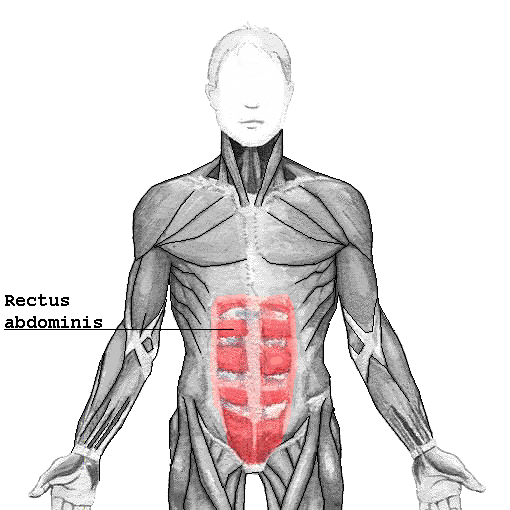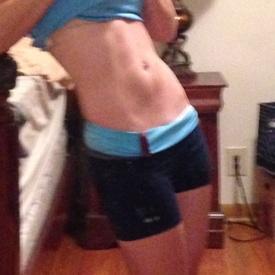Do sit ups work ?

gleesonstacey
Posts: 8 Member
Hi so I'm looking for some advise because a personal trainer at my gym told me sit ups and crunches are useless and planking is more effective but I'm really bad at planking and I enjoy sit ups but also don't want to waste my time ..any thoughts would be much appreciated
0
Replies
-
The trainer was 90% or so right, not totally useless but many things better including planks and plank variations.
I've found over a number of years the exercise moves you suck at are often the ones you need to be doing. This article talks about working up to ab roll-outs which are very effective.
https://www.t-nation.com/training/anterior-core-training0 -
What do you mean by "work" is the question. Do sit-ups help to build a stronger core? They absolutely do. Are they the most effective core strengthening exercise, no. Will they (or any ab isolation exercises for that matter) burn stomach fat or give you a flatter stomach; nope.0
-
KellyAnn1286 wrote: »What do you mean by "work" is the question. Do sit-ups help to build a stronger core? They absolutely do. Are they the most effective core strengthening exercise, no. Will they (or any ab isolation exercises for that matter) burn stomach fat or give you a flatter stomach; nope.
+10 -
All those wasted years crunching...
 0
0 -
You also have to figure in that most people do them wrong and don't engage their ab muscles which also decreases their effectiveness.0
-
Any physical activity vs sitting on your butt works0
-
Think about it this way... if you've been doing tons of sit ups because you enjoy them, but you're still really bad at planking--then apparently the sit ups really weren't doing anything to help improve your core strength...0
-
The best workout for your abs is to keep your core tight when doing any and all exercises. You can do sit ups and crunches until the cows come home. But when its all said and done, planking is a very good way to tone all of your core. Here is the saying, "When in doubt, plank it out!"
 0
0 -
KellyAnn1286 wrote: »What do you mean by "work" is the question. Do sit-ups help to build a stronger core? They absolutely do. Are they the most effective core strengthening exercise, no. Will they (or any ab isolation exercises for that matter) burn stomach fat or give you a flatter stomach; nope.
 0
0 -
I have been planking only for the last while (having read the same). But my daughter asked me to do a Fitness Blender core workout with her yesterday and I got a little reminder that planking alone isn't enough.0
-
Once you can hold a plank for 60 secs it's time to move on
Personally I don't plank - I do push-ups and variations .. staying still is dull 0
0 -
unfortunatey planking is more effective than crunches, hence why crunches are "easier". But I hear ya, I hate planking too haha0
-
gleesonstacey wrote: »Hi so I'm looking for some advise because a personal trainer at my gym told me sit ups and crunches are useless and planking is more effective but I'm really bad at planking and I enjoy sit ups but also don't want to waste my time ..any thoughts would be much appreciated
Do both.....I have noticed the difference since I have stopped doing them0 -
You could try a bit of a compromise between the two;
Sit up in half boat pose and contract your stomach muscles to bring your finger tips toward your toes. Do three sets of 10-20, resting for 5-10 seconds between. DON'T let your feet or shoulders touch the ground at rest.0 -
My issue with planking is my shoulders. Being 244lbs, it puts a lot of strain on me (tweaked my left shoulder a few years back in the Army.) So, I started working my shoulders a bit more to strengthen them up, and can now hold a 2 minute plank. Doing a single muscle exercise is pretty ineffective. Instead of focusing on just crunches/situps, find something that works your entire core. It'll burn more calories, and help you all around in every day activities.0
-
What are you trying to achieve?0
-
all the replies +10
-
Isolation holds are most effective, IMO. The core is a stabilizer... Maintaining tension throughout the movement (whatever the movement) is very important. Crunches will work the upper abdominals, hanging knee raises and leg raises (as you progress) will smash the lower abdominals. However, that's not all there is. Planks are great for working the transverse abdominis (the muscle underneath the "six pack" abdominal muscles, used primarily for stability and support for the spine). Also, as mentioned above, I would suggest everyone work their way up to performing ab-rollouts on a regular basis with good form. For most people, this movement takes time to get down. Start with a basic knee plank with a med ball under your elbows. Roll the med ball out so your torso is extended and come back to start. And eventually you'll be able to work up to push-up plank walk outs followed by the ab rollout.0
-
I'm glad to read all this good stuff about planks vs sit ups. I've been trying to do a 30 day plank challenge with a gradual increase of hold times. I've never been good at sit-ups, (they don't always agree with my back -probably because my form is horrible), and even though they can really difficult, I found that I can hold a plank better, and I'm hoping that getting stronger at planks will help me be able to do more strength exercises effectively.0
-
Man, I misread the Title and thought this was "Do Sit Ups At Work". I was going to say go for it, lol. But planking at work might be better.0
-
sjohnson__1 wrote: »Isolation holds are most effective, IMO. The core is a stabilizer... Maintaining tension throughout the movement (whatever the movement) is very important. Crunches will work the upper abdominals, hanging knee raises and leg raises (as you progress) will smash the lower abdominals. However, that's not all there is. Planks are great for working the transverse abdominis (the muscle underneath the "six pack" abdominal muscles, used primarily for stability and support for the spine). Also, as mentioned above, I would suggest everyone work their way up to performing ab-rollouts on a regular basis with good form. For most people, this movement takes time to get down. Start with a basic knee plank with a med ball under your elbows. Roll the med ball out so your torso is extended and come back to start. And eventually you'll be able to work up to push-up plank walk outs followed by the ab rollout.
There are no upper and lower abdominals...0 -
Abs are made in the kitchen... took me too many years to figure that out0
-
I have to be good at situps since they are part of the Army Physical Fitness Test. For the first couple years of my enlistment they were my worst category. last January I started doing the 300 ab workout after each gym workout which is a combination of several crunch variants and other ab workouts. By June I was coming within a couple situps of maxing out that category.0
-
stevencloser wrote: »sjohnson__1 wrote: »Isolation holds are most effective, IMO. The core is a stabilizer... Maintaining tension throughout the movement (whatever the movement) is very important. Crunches will work the upper abdominals, hanging knee raises and leg raises (as you progress) will smash the lower abdominals. However, that's not all there is. Planks are great for working the transverse abdominis (the muscle underneath the "six pack" abdominal muscles, used primarily for stability and support for the spine). Also, as mentioned above, I would suggest everyone work their way up to performing ab-rollouts on a regular basis with good form. For most people, this movement takes time to get down. Start with a basic knee plank with a med ball under your elbows. Roll the med ball out so your torso is extended and come back to start. And eventually you'll be able to work up to push-up plank walk outs followed by the ab rollout.
There are no upper and lower abdominals...
LOL. True... but different movements will work different areas of the rectus abdominis more directly. Just like certain movements and angles do when working pectoralis major -- incline bench, decline bench, flat bench.
0 -
The only people who should be doing situps are those who have to pass a physical fitness test for military, law enforcement, etc...and really, I hope these organizations come to the conclusion that it's really a waste of an exercise.
With both sit-ups and traditional crunches, you're working your hip flexors more than anything...people also "curl" their backs and put a lot of stress on their necks with these exercises.
If you're going to do crunches, do them on a bosu or exercise ball or a declined bench and make sure you keep your back straight and don't pull on your neck. Planks are a great core workout and there are numerous others. That said, I wouldn't put all of my energies into a bunch of direct core/ab work...you're going to be far better off doing compound movements with some core isolation at the end of your workout than you are doing endless isolation stuff.
Also keep in mind that core work isn't going to spot reduce fat...it's not going to flatten your stomach...losing fat in general is the only thing that is going to do that.0 -
All great info! Interesting read and opinions here.0
-
cwolfman13 wrote: »The only people who should be doing situps are those who have to pass a physical fitness test for military, law enforcement, etc...and really, I hope these organizations come to the conclusion that it's really a waste of an exercise.
With both sit-ups and traditional crunches, you're working your hip flexors more than anything...people also "curl" their backs and put a lot of stress on their necks with these exercises.
If you're going to do crunches, do them on a bosu or exercise ball or a declined bench and make sure you keep your back straight and don't pull on your neck. Planks are a great core workout and there are numerous others. That said, I wouldn't put all of my energies into a bunch of direct core/ab work...you're going to be far better off doing compound movements with some core isolation at the end of your workout than you are doing endless isolation stuff.
Also keep in mind that core work isn't going to spot reduce fat...it's not going to flatten your stomach...losing fat in general is the only thing that is going to do that.
There have been ongoing talks in the Army about changing the APFT to a more performance based test, buddy carrying, shuttle runs, stuff like that instead of pushups/situps/running. I personally hope they do change. In my last unit there was a guy who was 5'0" who could churn out pushups and situps like nobody's business, but me being 6'4", both having a longer distance to push/curl and more weight to move, has a harder time doing these exercises. However, i'm confident that i'm overall a stronger person and would have an easier time pulling someone wearing full combat armor out of a fire fight if need be. Plus, you get a lot of leaders who just PT for the test, and ignore other muscle groups like the back (my favorite to workout), legs, abs, etc. Rant over
0 -
cwolfman13 wrote: »The only people who should be doing situps are those who have to pass a physical fitness test for military, law enforcement, etc...and really, I hope these organizations come to the conclusion that it's really a waste of an exercise.
With both sit-ups and traditional crunches, you're working your hip flexors more than anything...people also "curl" their backs and put a lot of stress on their necks with these exercises.
If you're going to do crunches, do them on a bosu or exercise ball or a declined bench and make sure you keep your back straight and don't pull on your neck. Planks are a great core workout and there are numerous others. That said, I wouldn't put all of my energies into a bunch of direct core/ab work...you're going to be far better off doing compound movements with some core isolation at the end of your workout than you are doing endless isolation stuff.
Also keep in mind that core work isn't going to spot reduce fat...it's not going to flatten your stomach...losing fat in general is the only thing that is going to do that.
BINGO..
For me, it's all compound movements + a few iso movements.
(I rotate between hanging leg raises, hanging knee raises, ab-rollouts and weighted cable crunches. For obliques I do unilateral farmers carries. Nothing rigorous, maybe 2-3x a week on the isolation movements.)0 -
sjohnson__1 wrote: »stevencloser wrote: »sjohnson__1 wrote: »Isolation holds are most effective, IMO. The core is a stabilizer... Maintaining tension throughout the movement (whatever the movement) is very important. Crunches will work the upper abdominals, hanging knee raises and leg raises (as you progress) will smash the lower abdominals. However, that's not all there is. Planks are great for working the transverse abdominis (the muscle underneath the "six pack" abdominal muscles, used primarily for stability and support for the spine). Also, as mentioned above, I would suggest everyone work their way up to performing ab-rollouts on a regular basis with good form. For most people, this movement takes time to get down. Start with a basic knee plank with a med ball under your elbows. Roll the med ball out so your torso is extended and come back to start. And eventually you'll be able to work up to push-up plank walk outs followed by the ab rollout.
There are no upper and lower abdominals...
lol, just like there's no "upper and lower" pec... but different workouts will work different areas more directly. ie: incline bench, decline bench, flat bench...
Pectoralis major is made up of 3 parts that are layered top to bottom, going from your shoulder to your sternum.
Rectus abdomnis is one singular muscle each on the left and right side of your navel going from below your chest downwards to your crotch. There can't physically be an "upper and lower" part to it any more than there can be an upper and lower biceps.
The separation into a 6-8 pack is due to connective tissue located on top of it.0 -
I love planking. Sit-ups and crunches do nothing for me (interest wise).0
This discussion has been closed.
Categories
- All Categories
- 1.4M Health, Wellness and Goals
- 397.1K Introduce Yourself
- 44.2K Getting Started
- 260.9K Health and Weight Loss
- 176.3K Food and Nutrition
- 47.6K Recipes
- 232.8K Fitness and Exercise
- 456 Sleep, Mindfulness and Overall Wellness
- 6.5K Goal: Maintaining Weight
- 8.7K Goal: Gaining Weight and Body Building
- 153.4K Motivation and Support
- 8.3K Challenges
- 1.3K Debate Club
- 96.5K Chit-Chat
- 2.6K Fun and Games
- 4.6K MyFitnessPal Information
- 16 News and Announcements
- 18 MyFitnessPal Academy
- 1.4K Feature Suggestions and Ideas
- 3.1K MyFitnessPal Tech Support Questions





















